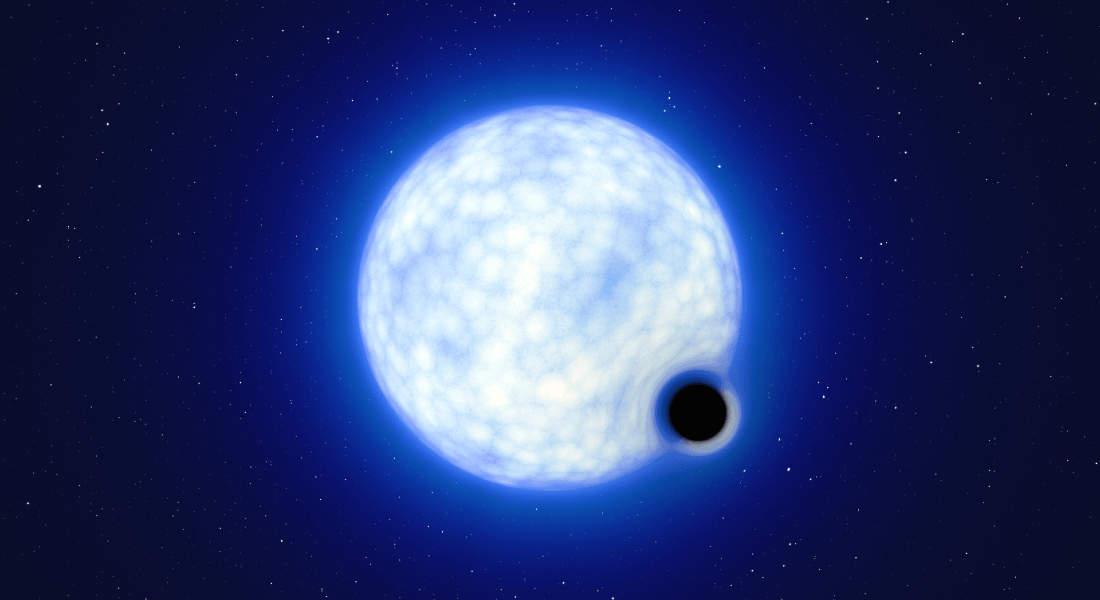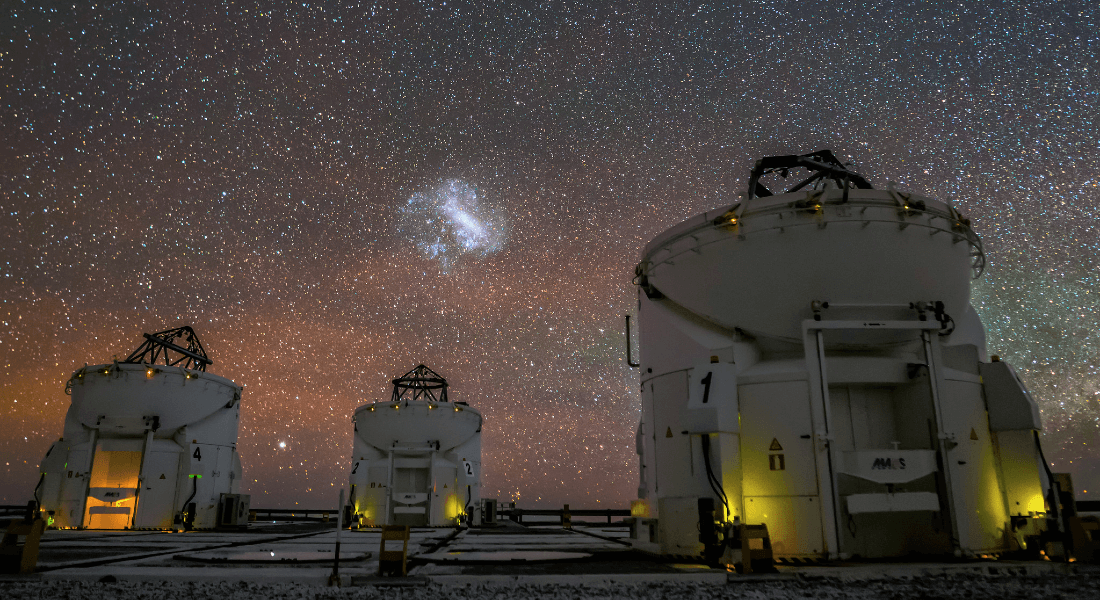From The Niels Bohr Institute [Niels Bohr Institutet] (DK)
At
The University of Copenhagen [Københavns Universitet] [UCPH] (DK)
5.21.24
ASTROPHYSICS University of Copenhagen astrophysicists help explain a mysterious phenomenon, whereby stars suddenly vanish from the night sky. Their study of an unusual binary star system has resulted in convincing evidence that massive stars can completely collapse and become black holes without a supernova explosion.

VFTS_243 in the Tarantula_Nebula. L. Calçada/The European Southern Observatory [La Observatorio Europeo Austral] [Observatoire européen austral][Europäische Südsternwarte](EU)(CL)
One day [in 3-5 billion years], the star at the center of our own solar system, the Sun, will begin to expand [becoming a red giant] until it engulfs Earth. It will then become increasingly unstable until it eventually contracts into a small and dense object known as a white dwarf.

However, if the Sun were of a weight class roughly eight times greater or more, it would probably go out with a huge bang – as a supernova. Its collapse would culminate into an explosion, ejecting energy and mass into space with enormous force, prior to leaving behind a neutron star or a black hole in its wake.
While this is basic knowledge about how massive stars die, there remains plenty to understand about the starry skies above and the spectacular death of these stars in particular.
New research [Physical Review Letters] by astrophysicists at the University of Copenhagen’s Niels Bohr Institute presents the strongest evidence to date that very massive stars can succumb with far more stealth and discretion than as supernovae. Indeed, their investigation suggests that, with enough mass, a star’s gravitational pull can be so strong that no explosion takes place upon its death. Instead, the star can go through what is known as a complete collapse.
This discovery is linked to the phenomenon of disappearing stars, which has interested astronomers in recent years, and it may provide both a clear-cut example as well as a plausible scientific explanation for phenomena of this kind.
“Were one to stand gazing up at a visible star going through a total collapse, it might, just at the right time, be like watching a star suddenly extinguish and disappear from the heavens. The collapse is so complete that no explosion occurs, nothing escapes and one wouldn’t see any bright supernova in the night sky. Astronomers have actually observed the sudden disappearance of brightly shining stars in recent times. We cannot be sure of a connection, but the results we have obtained from analyzing VFTS 243 has brought us much closer to a credible explanation,” says Alejandro Vigna-Gómez.

VFTS 243 in NASA/ESA Hubble Space Telescope color
Date 2022
Source Own work
Author Pelligton and Aladin Sky Atlas in HST color

An unusual star system with no signs of an explosion
This discovery has been prompted by the recent observation of an unusual binary star system at the edge of our galaxy called VFTS 243. Here, a large star and black hole roughly 10 times more massive than our Sun orbit one another.
The researchers have analyzed the observational data for a range of signs that would be expected from a star system having undergone a supernova-explosion in the past. Generally, they found evidence of such an event minor and unconvincing.
The system does not show sign of a significant “natal kick”, an acceleration of the orbiting objects. It is also very symmetrical, almost perfectly circular in it’s orbit, and remaining signs from the energy release during the core collapse of the former star points to a type of energy consistent with complete collapse.
“Our analysis unequivocally points to the fact that the black hole in VFTS 243 was most likely formed immediately, with the energy mainly being lost via neutrinos,” says Professor Irene Tamborra from the Niels Bohr Institute, who also participated in the study.

The binary star system VFTS 243 is located in the dwarf galaxy “Large Magellanic Cloud” in the periphery of the Milky Way. Credit: J.C.Munõz, ESO, CC BY-SA 4.0
Zooming In on Binary System VFTS 243 in the Tarantula Nebula, a part of the LMC.


A benchmark system for future studies
According to Professor Tamborra, the VFTS 243 system opens the possibility for finally comparing a range of astrophysics theories and model calculations with actual observations. She expects that the star system will be important for studying stellar evolution and collapse.
“Our results highlight VFTS 243 as the best observable case so far for the theory of stellar black holes formed through total collapse, where the supernova explosion fails and which our models have shown to be possible. It is an important reality check for these models. And we certainly expect that the system will serve as a crucial benchmark for future research into stellar evolution and collapse,” says the professor.
See the full article here .
Comments are invited and will be appreciated, especially if the reader finds any errors which I can correct.

five-ways-keep-your-child-safe-school-shootings
The Niels Bohr Institute [Niels Bohr Institutet] (DK) is a research institute of The University of Copenhagen [Københavns Universitet] [UCPH] (DK). The research of the institute spans astronomy, geophysics, nanotechnology, particle physics, quantum mechanics and biophysics.
The Institute was founded in 1921, as the Institute for Theoretical Physics of the Københavns Universitet [UCPH] (DK), by the Danish theoretical physicist Niels Bohr, who had been on the staff of the University of Copenhagen since 1914, and who had been lobbying for its creation since his appointment as professor in 1916. On the 80th anniversary of Niels Bohr’s birth – October 7, 1965 – the Institute officially became The Niels Bohr Institutet (DK). Much of its original funding came from the charitable foundation of the Carlsberg brewery, and later from the Rockefeller Foundation.
During the 1920s, and 1930s, the Institute was the centre of the developing disciplines of atomic physics and quantum physics. Physicists from across Europe (and sometimes further abroad) often visited the Institute to confer with Bohr on new theories and discoveries. The Copenhagen interpretation of quantum mechanics is named after work done at the Institute during this time.
On January 1, 1993 the institute was fused with the Astronomic Observatory, the Ørsted Laboratory and the Geophysical Institute. The new resulting institute retained the name Niels Bohr Institutet (DK).

The University of Copenhagen [Københavns Universitet] [UCPH] (DK) is the oldest university and research institution in Denmark. Founded in 1479 as a studium generale, it is the second oldest institution for higher education in Scandinavia after Uppsala University [Uppsala universitet](SE) (1477). The university has 23,473 undergraduate students, 17,398 postgraduate students, 2,968 doctoral students and over 9,000 employees. The university has four campuses located in and around Copenhagen, with the headquarters located in central Copenhagen. Most courses are taught in Danish; however, many courses are also offered in English and a few in German. The university has several thousands of foreign students, about half of whom come from Nordic countries.
The university is a member of the International Alliance of Research Universities (IARU), along with University of Cambridge (UK), Yale University , The Australian National University (AU), and University of California-Berkeley , amongst others. The Academic Ranking of World Universities ranks the University of Copenhagen as the best university in Scandinavia and high in the world. The Times Higher Education World University Rankings has ranked the University of Copenhagen very high in the world. The QS World University Rankings has ranked the University of Copenhagen very high in the world. The university has had Nobel laureates and Turing Award recipients.


